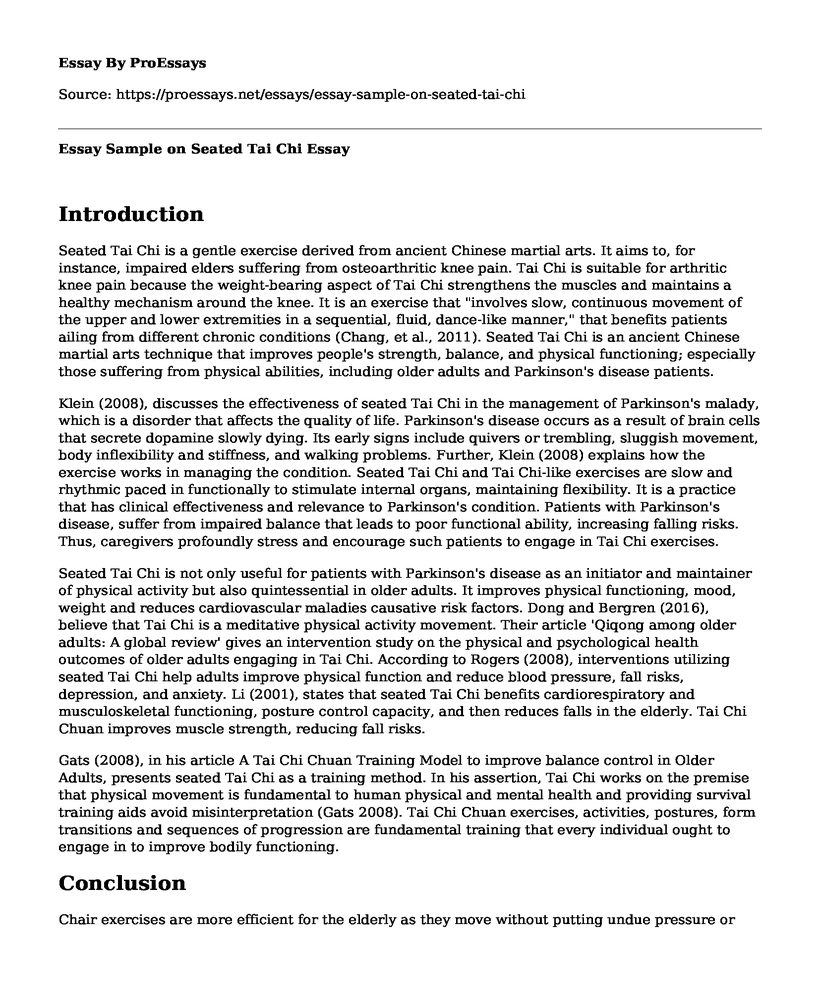Introduction
Seated Tai Chi is a gentle exercise derived from ancient Chinese martial arts. It aims to, for instance, impaired elders suffering from osteoarthritic knee pain. Tai Chi is suitable for arthritic knee pain because the weight-bearing aspect of Tai Chi strengthens the muscles and maintains a healthy mechanism around the knee. It is an exercise that "involves slow, continuous movement of the upper and lower extremities in a sequential, fluid, dance-like manner," that benefits patients ailing from different chronic conditions (Chang, et al., 2011). Seated Tai Chi is an ancient Chinese martial arts technique that improves people's strength, balance, and physical functioning; especially those suffering from physical abilities, including older adults and Parkinson's disease patients.
Klein (2008), discusses the effectiveness of seated Tai Chi in the management of Parkinson's malady, which is a disorder that affects the quality of life. Parkinson's disease occurs as a result of brain cells that secrete dopamine slowly dying. Its early signs include quivers or trembling, sluggish movement, body inflexibility and stiffness, and walking problems. Further, Klein (2008) explains how the exercise works in managing the condition. Seated Tai Chi and Tai Chi-like exercises are slow and rhythmic paced in functionally to stimulate internal organs, maintaining flexibility. It is a practice that has clinical effectiveness and relevance to Parkinson's condition. Patients with Parkinson's disease, suffer from impaired balance that leads to poor functional ability, increasing falling risks. Thus, caregivers profoundly stress and encourage such patients to engage in Tai Chi exercises.
Seated Tai Chi is not only useful for patients with Parkinson's disease as an initiator and maintainer of physical activity but also quintessential in older adults. It improves physical functioning, mood, weight and reduces cardiovascular maladies causative risk factors. Dong and Bergren (2016), believe that Tai Chi is a meditative physical activity movement. Their article 'Qiqong among older adults: A global review' gives an intervention study on the physical and psychological health outcomes of older adults engaging in Tai Chi. According to Rogers (2008), interventions utilizing seated Tai Chi help adults improve physical function and reduce blood pressure, fall risks, depression, and anxiety. Li (2001), states that seated Tai Chi benefits cardiorespiratory and musculoskeletal functioning, posture control capacity, and then reduces falls in the elderly. Tai Chi Chuan improves muscle strength, reducing fall risks.
Gats (2008), in his article A Tai Chi Chuan Training Model to improve balance control in Older Adults, presents seated Tai Chi as a training method. In his assertion, Tai Chi works on the premise that physical movement is fundamental to human physical and mental health and providing survival training aids avoid misinterpretation (Gats 2008). Tai Chi Chuan exercises, activities, postures, form transitions and sequences of progression are fundamental training that every individual ought to engage in to improve bodily functioning.
Conclusion
Chair exercises are more efficient for the elderly as they move without putting undue pressure or strain on their bodies. Seated Tai Chi, for example, keeps the joints flexible by lubricating them and strengthening individual muscles, which also facilitates blood circulation. Suzie (2012), states that seated Tai Chi reduced medical costs associated with physical therapy as it serves a similar function. Seated Tai Chi is an alternative means for assisting or increasing mobility and physical functioning if well utilized through proper training. It engaged body muscles, joints, and systems, keeping them alert and strengthened for better physical movement.
References
Chang, J., Tsai, P.-F., Woods, S., Beck, C., Roberson, P., & Rosengren, K. (2011). Teaching Tai Chi to elders with osteoarthritis pain and mild cognitive impairment. American Journal of Recreational Therapy, 10(1), 11-16.
Dong, X., & Bergren, S. (2016). Qigong among older adults: A global review. Clinical Research and Trials, 2 (1). Doi:10.15761/crt.1000130
Gatts, S. (2008). A Tai Chi Chuan training model to improve balance control in older adults. Current Aging Sciencee, 1(1), 68-70. doi:10.2174/1874609810801010068 https://pdfs.semanticscholar.org/fae6/76c99ea1c355123e0e0554c531d71eadda0b.pdf
Klein, P. J. (2008). Tai Chi Chuan in the Management of Parkinson's Disease and Alzheimer's Disease. Medicine and Sport Science Tai Chi Chuan,173-181. doi:10.1159/000134298
Li, J. X. (2001). Tai chi: Physiological characteristics and beneficial effects on health. British Journal of Sports Medicine, 35(3), 148-156. doi:10.1136/bjsm.35.3.148 http://bjsm.bmj.com/content/35/3/148
Suzie W. L. Lane, Edd, Ctrs, & Ctrs, S. C. (2012). Impact of seated Tai Chi on range of motion as a therapeutic recreation intervention. American Journal of Recreation Therapy, 11(4), 14-18. doi:10.5055/ajrt.2012.0030 https://sites.temple.edu/rtwiseowls/2016/07/16/impact-of-seated-tai-chi-on-range-of-motion-as-a-therapeutic-recreation-intervention/
Cite this page
Essay Sample on Seated Tai Chi. (2022, Apr 16). Retrieved from https://proessays.net/essays/essay-sample-on-seated-tai-chi
If you are the original author of this essay and no longer wish to have it published on the ProEssays website, please click below to request its removal:
- Brief Synopsis of the Article on Patient-Centered Care
- Public Reporting of Medical Errors - Paper Example on Public Health
- Sensa Weight Loss Regimen Review Paper Example
- Essay Sample on Health Records of Children: Parental Responsibility & Electronic Confirmation
- Essay Example on Women's Health: Ensuring Non-Discriminatory Care & Accessibility
- Problem Solution Essay on Reproductive Health
- Essential Workers: Key Players in Coronavirus Crisis - Essay Sample







